
Sciadopitys verticillata, the kōyamaki or Japanese umbrella-pine, is a unique conifer endemic to Japan. It is the sole living member of the family Sciadopityaceae and genus Sciadopitys, a living fossil with no close relatives. The oldest fossils of Sciadopitys are from the Late Cretaceous of Japan, and the genus was widespread in Laurasia during most of the Cenozoic, especially in Europe until the Pliocene. An extinct European relative of this species may have been the primary producer of Baltic amber.
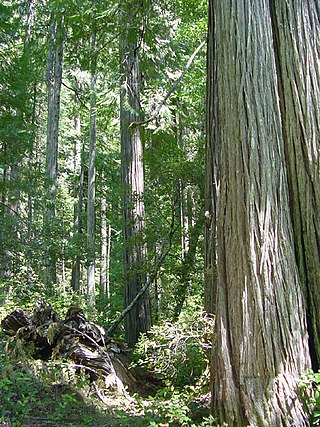
Chamaecyparis lawsoniana, known as Port Orford cedar or Lawson cypress, is a species of conifer in the genus Chamaecyparis, family Cupressaceae. It is native to Oregon and northwestern California, and grows from sea level up to 4,900 feet (1,500 m) in the valleys of the Klamath Mountains, often along streams.

Platycladus is a monotypic genus of evergreen coniferous trees in the cypress family Cupressaceae, containing only one species, Platycladus orientalis, also known as Chinese thuja, Oriental arborvitae, Chinese arborvitae, biota or Oriental thuja. It is native to northeastern parts of East Asia and North Asia, but is also now naturalised as an introduced species in other regions of the Asian continent.

Pinus parviflora, also known as five-needle pine, or Japanese white pine, is a pine in the white pine group, Pinus subgenus Strobus, native to Japan.
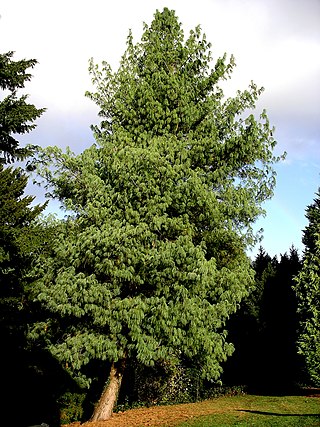
Pinus wallichiana is a coniferous evergreen tree native to the Himalaya, Karakoram and Hindu Kush mountains, from eastern Afghanistan east across northern Pakistan and north west India to Yunnan in southwest China. It grows in mountain valleys at altitudes of 1800–4300 m, reaching 30–50 m (98–164 ft) in height. It favours a temperate climate with dry winters and wet summers. In Pashto, it is known as Nishtar.
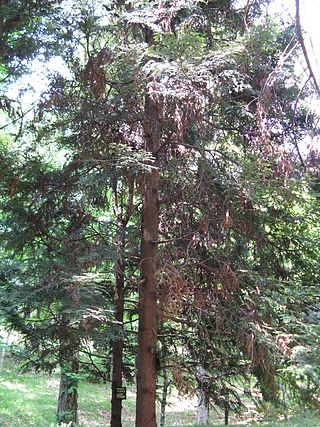
Thujopsis is a genus of conifers in the cypress family (Cupressaceae), the sole member of which is Thujopsis dolabrata. It is endemic to Japan, where it is named asunaro (あすなろ). It is similar to the closely related genus Thuja (arborvitae), differing in the broader, thicker leaves and thick cones.

Abies pinsapo, the Spanish fir, is a species of tree in the family Pinaceae, native to southern Spain and northern Morocco. Related to other species of Mediterranean firs, it appears at altitudes of 900–1,800 metres (3,000–5,900 ft) in the Sierra de Grazalema in the Province of Cádiz and the Sierra de las Nieves and Sierra Bermeja, both near Ronda in the province of Málaga. In Morocco, it is limited to the Rif Mountains at altitudes of 1,400–2,100 metres (4,600–6,900 ft) on Jebel Tissouka and Jebel Tazaot.

Picea orientalis, commonly known as the Oriental spruce or Caucasian spruce, is a species of spruce native to the Caucasus and adjacent northeast Turkey.

Cupressus arizonica, the Arizona cypress, is a North American species of tree in the cypress family Cupressaceae, native to the southwestern United States and Mexico. Populations may be scattered rather than in large, dense stands.

Microbiota is a monotypic genus of evergreen coniferous shrubs in the cypress family Cupressaceae, containing only one species, Microbiota decussata. The plant is native and endemic to a limited area of the Sikhote-Alin mountains in Primorskiy Krai in the Russian Far East. Microbiota is not to be confused with the range of microorganisms of the same name. The genus name was derived from micro-, meaning "small", + Biota, the genus name for a closely related conifer, a species formerly called Biota orientalis, now renamed Platycladus orientalis.

Larix kaempferi, the Japanese larch or karamatsu in Japanese, is a species of larch native to Japan, in the mountains of Chūbu and Kantō regions in central Honshū.
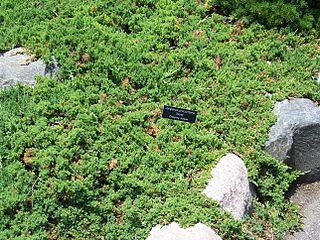
Juniperus procumbens is a species of shrub in the cypress family Cupressaceae, native to Japan. This low-growing evergreen conifer is closely related to the Chinese juniper, Juniperus chinensis, and is sometimes treated as a variety of it, as J. chinensis var. procumbens.

Juniperus squamata, the flaky juniper, or Himalayan juniper is a species of coniferous shrub in the cypress family Cupressaceae, native to the Himalayas and China.
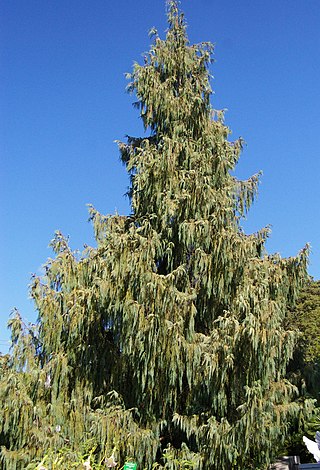
Cupressus cashmeriana, the Bhutan cypress or Kashmir cypress, is a species of evergreen conifer native to the eastern Himalaya in Bhutan and adjacent areas of Arunachal Pradesh in northeastern India. [ Now in vulnerable category, IUCN list retrieved in 2006 ]. It is also introduced in China and Nepal. It grows at moderately high altitudes of 1,250–2,800 metres (4,100–9,190 ft).

Conophytum jucundum is a species of succulent plants belonging to the family Aizoaceae. As its synonym Conophytum gratum, the pleasing cone plant, it has gained the Royal Horticultural Society's Award of Garden Merit.

Conophytum flavum, the yellow cone plant, is a small South African species of succulent flowering plant of the family Aizoaceae.

Conophytum obcordellum is a species of flowering plant in the family Aizoaceae, native to the Western Cape of South Africa. It is a small clump-forming succulent, growing to 10 cm tall and 1 m broad, forming glossy grey pebble-shaped growths, heavily marked with dots and lines. Daisy-like, silky white or pink night-scented flowers are borne on mature plants in spring.
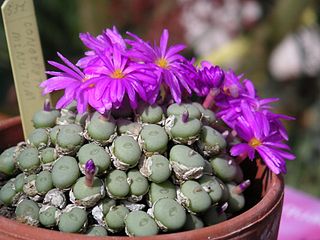
Conophytum minutum, called the lesser dumpling, is a species of flowering plant in the genus Conophytum, native to the western Cape Provinces of South Africa. It has gained the Royal Horticultural Society's Award of Garden Merit.

Conophytum pellucidum, called the transparent cone plant, is a species of flowering plant in the genus Conophytum, native to the western Cape Provinces of South Africa. It has gained the Royal Horticultural Society's Award of Garden Merit.
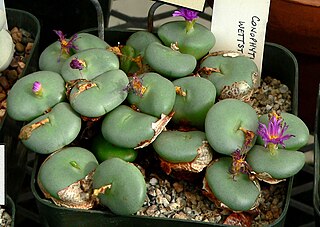
Conophytum wettsteinii is a species of flowering plant in the genus Conophytum, native to the northwest Cape Provinces of South Africa. It is known to grow in rocky regions, often nearby Crassula elegans. C. wettsteinii is a small groundcover species, which appears stemless with fused leaf-pairs having a obconical shape. This plant relies on winter rains and is mainly dormant in summer months. Best growth occurs when drainage is available, and when only shaded during mid-summer. Propegation can occur through seeds or through cuttings from a full grown plant, where each cutting contains at least 1 head and a fraction of root. It has gained the Royal Horticultural Society's Award of Garden Merit.





















